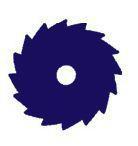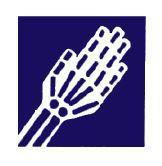SAS Urban Survival Handbook (68 page)
Read SAS Urban Survival Handbook Online
Authors: John Wiseman
Tags: #Health & Fitness, #Reference, #Survival, #Fiction, #Safety, #Self-Help, #Personal & Practical Guides, #General, #Survival Skills

Scaffolding and other high work sites must have barriers to prevent anyone accidentally stepping off.
SAFE MACHINE OPERATION
When operating any machinery – industrial or otherwise – – never start the machinery until you can answer ‘yes’ to ALL the following questions:
- ■
Do you know how to stop the machine? - ■
Are all fixed guards fitted properly and all mechanical guards in working order? - ■
Is the area round the machine clean, tidy and free from obstruction? - ■
Are you wearing appropriate protective clothing, safety glasses, shoes, gloves etc?
IF you have ANY doubt about whether a machine is working properly, inform your supervisor immediately.
Machine guards
Fixed guards prevent contact by any part of the body with dangerous parts of the machine. Interlocking guards ensure openings are automatically closed before the machine can be operated and stay closed until the operation is ended.
Automatic guards may be operated by photoelectric cells, contact with a physical barrier or pressure-sensitive mats. These stop the machine or prevent it starting if someone is too close to the machine.
REMEMBER
Check that guards are in place and automatic devices are working properly BEFORE starting any machine. NEVER TAKE RISKS! By the time a machine is stopped you may have lost a limb or your life.
It’s up to you!
Sometimes an employer or manager may fail to implement proper safety measures, to save money or speed up output. The individual worker may make the decision to work without protection—especially when safety equipment is cumbersome or uncomfortable. It is the responsibility of EVERY individual to know and understand risks and to see that adequate provision is made to ensure work safety.
A study by the British government’s Health and Safety Executive showed that carelessness and human error were the cause of only a small proportion of accidents at work—the main cause was the employer’s failure to provide a safe system of work. Make SURE that this is not the case at your workplace.
Vibration
The long-term use of vibrating tools, such as pneumatic drills, hammers or chisels, chain saws and electric grinders, can cause hand/arm problems leading to permanent damage.
Vibration damages the tendons, the nerves and the blood capillaries and may even lead to decalcification of the small bones in the hand. This damage frequently shows itself as vibration white finger (VBI, also known as dead finger or Reynaud’s phenomenon)—an untreatable condition which has been known as a risk to stone cutters, riveters and road workers for many years. Although there is no ‘cure’, the conditions may improve if exposure to vibration is avoided.
The first noticeable symptom of white finger may be an intermittent tingling in the fingers. Next is intermittent numbness. Even when there is a blanching of one or more fingertips (with or without tingling or numbness) this may not interfere with the use of the hand. The condition can progress to affect more of the finger.
In cold winter weather, when the reduction of the blood supply is more noticeable, the condition is likely to be worse and the victim may find it interferes with the use of the hands.
When blanching is extensive and begins to occur in warmer months, the condition is usually bad enough to affect all finger use. If you think you have the early symptoms, see a doctor to be sure, and try to change the kind of work you do before the condition develops further.
Whole body vibration
This occurs when the whole body is shaken by a machine or vehicle. The effects vary according to the frequency and strength of the vibration and the length of exposure to it. A frequency of less than once per second can induce motion sickness; from one to 80 vibrations per second can lead to tiredness, disturbed sleep, blurred vision, piles, hernias and damage to internal organs. Bus and heavy goods vehicle drivers may be subjected to constant engine juddering.
Suspended cabs in vehicles and improved mounting and maintenance of machinery can reduce the problem by eliminating vibration or helping to isolate workers from it. If vibration does occur, the periods of exposure should be kept as short as possible to minimize the health risks.
NOISE
 A great many jobs are noisy by necessity. Noise-induced hearing loss is among the most common work-related injuries and disorders. It is usually due to temporary threshold shift (TTS)—the persistent noise level causes the hair cells of the inner ear to shift their field of sensitivity upwards and they no longer respond to soft sounds.
A great many jobs are noisy by necessity. Noise-induced hearing loss is among the most common work-related injuries and disorders. It is usually due to temporary threshold shift (TTS)—the persistent noise level causes the hair cells of the inner ear to shift their field of sensitivity upwards and they no longer respond to soft sounds.
Temporary hearing loss (‘auditory fatigue’) can occur after only a few minutes’ exposure to intense noise, but is usually reversible after a period of time away from noise. When exposure occurs over months or years, only partial recovery may be possible. Deafness to certain frequencies or even total hearing loss may be experienced. Where those exposed to noise are never away from work for more than two days, temporary hearing loss is likely to become permanent hearing loss.
Workers in manufacturing industries exposed to high levels of machine sound are the most likely to develop noise-induced hearing loss. The woodworking industry creates some of the highest noise levels:
- ◑ 100 dB (bandsaws/panel planers)
- ◑ 105 dB (edge banders/multi-cutter moulding machines)
- ◑ 107 dB (bench saws/high-speed routers)
Road and rail workers, airport ground staff and nightclub workers are among many others exposed to high noise levels.
If noise cannot be eliminated or reduced by redesigning the process or the machinery, some alleviation can be obtained by enclosing the machinery or blocking the noise transmission path, using acoustic chambers, hoods or guards.
Enclosing workers employed in quieter areas is a parallel measure if they are not working on or do not have to be in direct contact with the noise-producing machine. The risk can be further reduced by reducing shift times in the noisy areas.
Individual hearing protection
Ear muffs, plugs or canal caps on a headband can all be used to block sound from reaching the ears—but they do not remove the hazard. Personal hearing protection must be worn BEFORE entering the work area or switching on noise-producing machinery. It must
not
be removed while still exposed to high noise levels—not even for a couple of minutes. In a jet engine room, for instance, where noise levels reach 117dB, removing ear protection for as little as one minute would give a ‘dose’ equivalent to the recommended maximum of 90dB for eight hours.
CHECK: Hearing protection should be compatible with other safety equipment—especially when worn with helmets (see DIY/CRAFT HAZARDS).

WARNING
Wearing ear protectors makes verbal communication difficult (unless radio headphone systems are used) and also muffles any warning alarms or disguises the source of sounds, which could lead to accidents.
PROTECT YOUR SIGHT
Does your work put you at risk from any of the following?
- ■
Flying particles of any material - ■
Splashing of liquids - ■
Dust - ■
Irritation by fumes or vapours - ■
Molten metal splash - ■
Exposure to infra-red or ultra-violet light, lasers or strong visible light YOUR SIGHT MUST BE PROTECTED. Whether plain or filtering goggles, head covers or separate fixed or movable shields are suitable depends upon the process (see DIY/CRAFT HAZARDS: Protecting eyes).
REMEMBER
It is not only the operative who is at risk. Bystanders where oxyacetylene burners and similar tools are in use are particularly liable to ‘arc eye’, acute eye inflammation (and possible permanent damage) caused by exposure to ultra-violet light (see DIY/CRAFT HAZARDS: Welding).
▶ Additional information on safety in the work area and protective clothing can be found in DIY/CRAFT HAZARDS.
RADIATION RISKS
 Everyone must now be aware of the need for protection from radioactivity, whether in the nuclear industry, medicine or the laboratory. Any form of radiation can be harmful above certain levels and radiographers, dental nurses and others who operate x-ray machines must ALWAYS be screened.
Everyone must now be aware of the need for protection from radioactivity, whether in the nuclear industry, medicine or the laboratory. Any form of radiation can be harmful above certain levels and radiographers, dental nurses and others who operate x-ray machines must ALWAYS be screened.
Light is a form of radiation and, although visible levels of light are not usually harmful, exposure to ultra-violet light, emitted by many photocopiers, can damage the eye. The lid on the machine should cut out most of this radiation, but some blue light often gets through and can damage the retina of the receptor cells at the back of the eye.
Fluorescent lighting also emits ultra-violet light, but at lower levels. Many people find that working under fluorescent lighting causes sore eyes, headaches—even nausea.
Lasers can cause retinal damage—NEVER stare at them. Workers in jobs where they routinely look at very hot surfaces, such as molten metal and glass, may run the risk of developing opacities in the lens of the eye. Filtered goggles should be worn. Radiant heat can also cause overheating of the body and heatstroke.

WARNING
Photocopiers: In addition to ultra-violet radiation photocopiers produce bath hydrocarbon and ozone emissions. Nitrous oxide is also sometimes produced and toner dust is suspected of being carcinogenic. Liquid toners can also give off fumes which can produce dizziness and nausea if inhaled. Site copiers where ventilation is good. Limit time spent near a copier. Do NOT make copies with the machine uncovered, no matter how laborious or time-consuming the job.